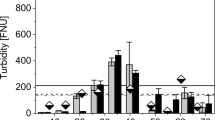Summary
An anaerobic filter system with a volume of 11 l fed with wastewater from the Swiss sugar refinery in Frauenfeld was established on a laboratory scale. It provided a filter performance of over 8 kg COD·m−3·d−1 with an efficiency of at least 70%. A 600–1 pilot plant system in the factory gave a degradation efficiency of 70% when fed with 28 kg COD·m−3·d−1 and yielded 0.34 m3 methane/kg COD, demonstrating that the scaling-up of the anaerobic filter had been successful. The rapidly-varying concentrations of organic materials in the wasterwater required the constant control of the wastewater flow to the system. A control program was developed for a small computer using an empirical model simulating the operator. By varying the influx rate of the wastewater to the anaerobic filter the computer kept the system at an optimal organic load. The results obtained were equivalent to those obtained by permanent control of the system by an operator.
Similar content being viewed by others
References
Aivasidis, A., Scale-up of a new fixed bed loop reactor for anaerobic digestion. 3rd Eur. Congress Biotechnology, vol. 3 (1984) 51–60.
de Vletter, R., and van Gils, W., COD balances as a tool in the wastewater management of sugar factories. Zucker29 (1976) 53–57.
Genung, R. K., Million, D. L., Hancher, C. W., and Pitt, W. W. Jr, Pilot plant demonstration of an anaerobic fixed-film bioreactor for wastewater treatment. Biotechnol. Bioeng. Symp.8 (1978) 329–344.
Isaac, P. C. G., Waste treatment, in: Waste Water Engineering. Eds Metcalf and Eddy. McGraw Hill, New York 1960.
Jewell, W. J., Switzenbaum, M. S., and Morris, J. W., Municipal wastewater treatment with the anaerobic attached microbial film expanded bed process. J. Wat. Pollut. Control Fed.53 (1981) 482–490.
Lettinga, G., Van Welson, S. W., Hobman, W., De Zeeuw, W., and Klapwyk, A., Use of the upflow sludge blanket (USB) reactor concept for biological wastewater treatment especially for anaerobic treatment. Biotechnol. Bioeng.22 (1980) 699–734.
Nyns, E. J., Digesters. A worldwide review. 1st Int. Symp. Anaerobic Digestion, Cardiff, Wales (1979).
Parikh, J. K., and Parikh, K. S., Potential of biogas plants and how to realize it, in: Microbial Energy Conversion. Eds Schlegel and Barnea. Pergamon Press, 1976.
Tesch, W. A., Methanerzeugung und Abbau organischer Stoffe in einem anaeroben Festbettreaktor (Anaerobfilter). Master thesis, University of Zürich, 1981.
Tesch, W. A., Schneider, K., and Bachofen, R., Performance of an anaerobic filter for purification and methane production from wastewater of a sugar refinery. Process Biochem. Jan./Feb. (1983) 34–37.
Van den Berg, L., and Kennedy, K. J., Support materials for stationary fixed film reactors for high-rate methanogenic fermentations. Biotechnol. Lett.3 (1980) 165–170.
Young, J. C., and McCarty, P. L., The anaerobic filter for waste treatment. Proc. 22nd Purdue Industrial Waste Conference, Ann Arbor, p. 559–574. Ann Arbor Science Publishers Inc., MI, 1967.
Author information
Authors and Affiliations
Rights and permissions
About this article
Cite this article
DaPra, E., Schneider, K. & Bachofen, R. Computer optimization of the performance of an anaerobic filter used for purification of highly polluted wastewater from a sugar refinery. Experientia 45, 1024–1029 (1989). https://doi.org/10.1007/BF01950153
Published:
Issue Date:
DOI: https://doi.org/10.1007/BF01950153




